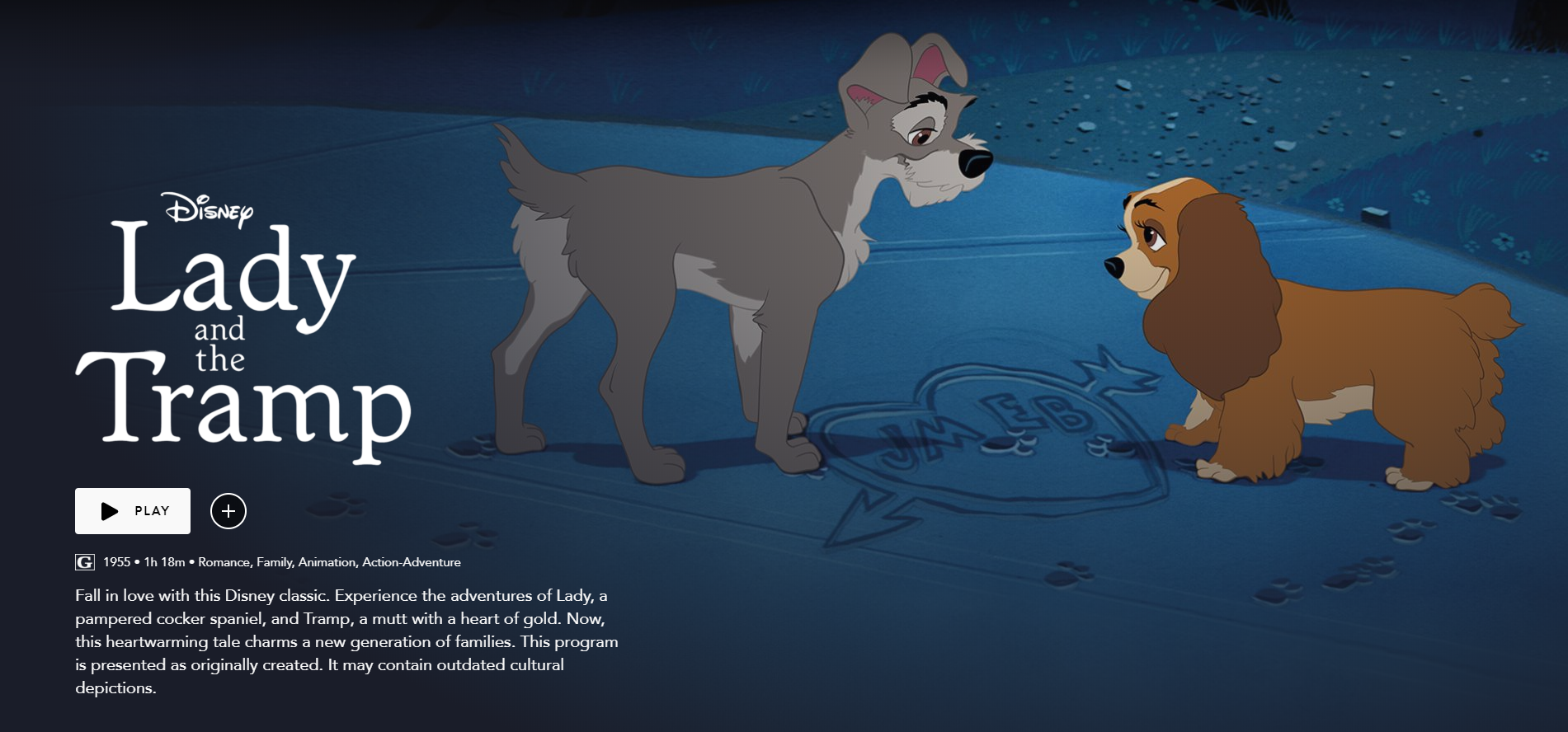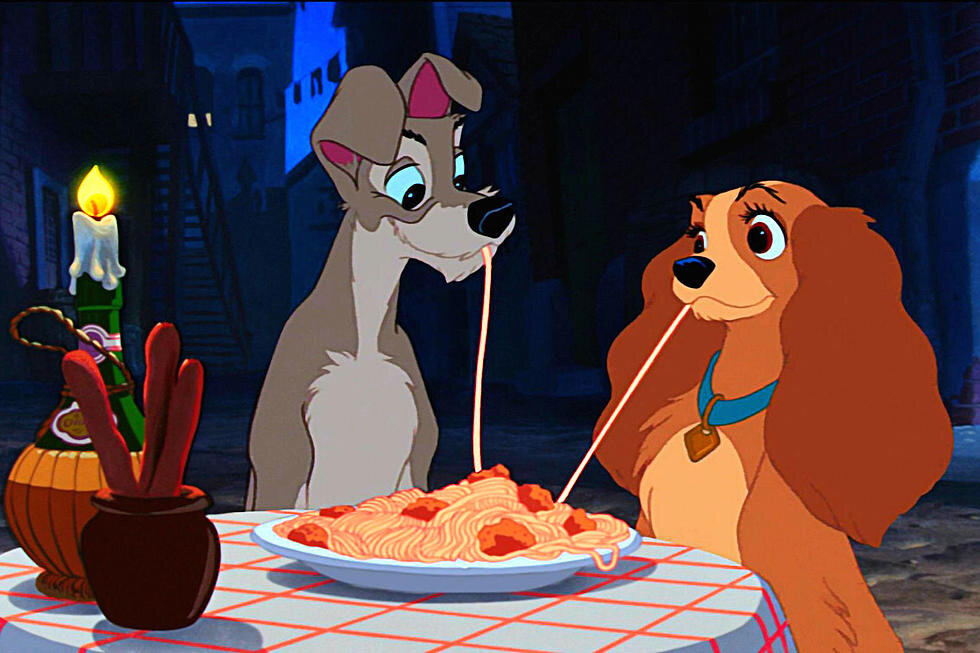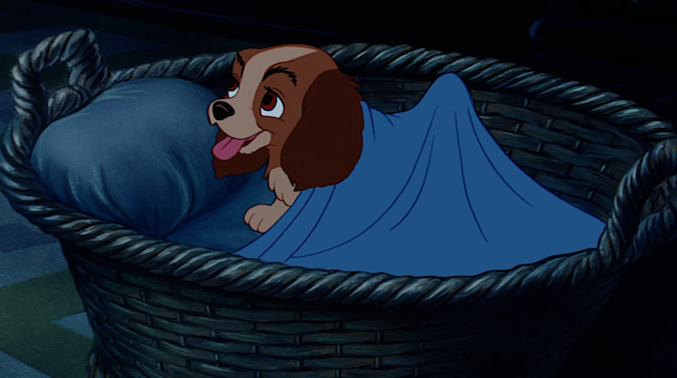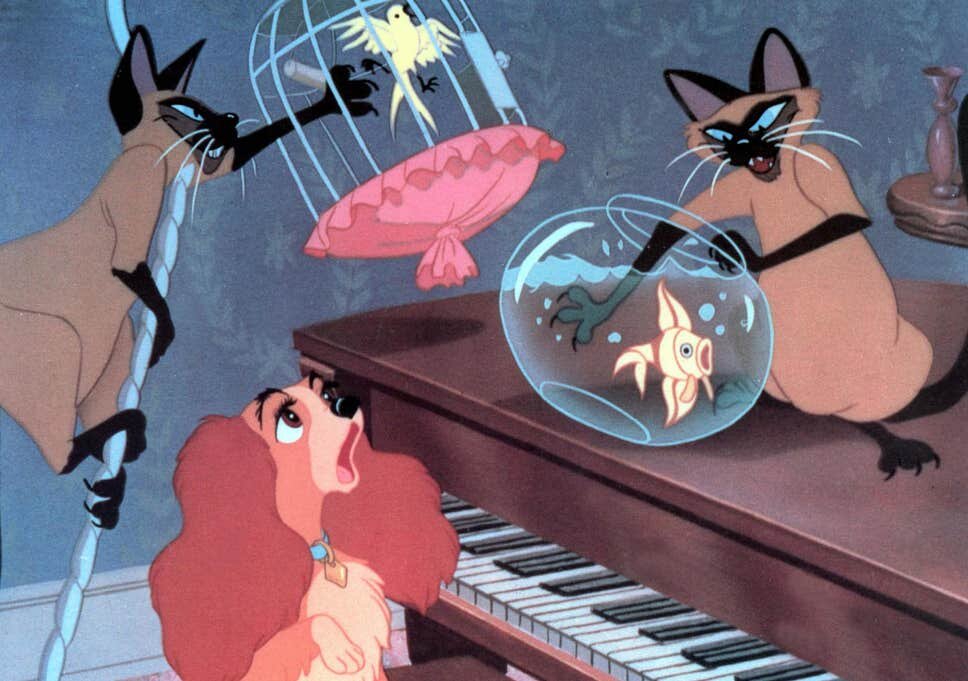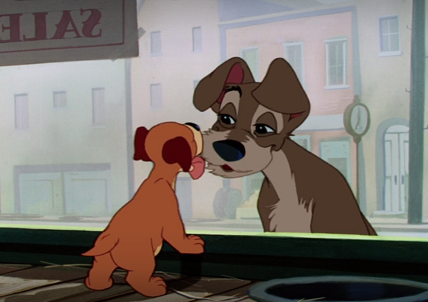Review: Lady and the Tramp (DMC #21)
Welcome back, Disnerds! We hope you all enjoyed joining us for the 21st movie in the Disnerd Movie Challenge, Lady and the Tramp! We certainly had fun rewatching this film together. Read on for our recap, or scroll through to get to our review.
Synopsis
On Christmas Eve, Jim Dear gifts his wife, Darling, a cocker spaniel puppy, which she names Lady. Lady quickly becomes a joyful member of the family, enjoying life with Jim Dear, Darling, and the neighboring dogs, Jaq and Trusty. Meanwhile, on the other side of town, a stray dog named Tramp lives a carefree life on his own, though he’s constantly on the run from the dog catcher. One day, Lady confides in Jaq and Trusty that Jim Dear and Darling haven’t been acting like themselves, and they haven’t been as kind to Lady. Her friends knowingly tell her that Jim Dear and Darling are expecting a baby, and express how wonderful babies are. Just then, Tramp, who’s just outrun the dog catcher, prances into the yard, adding his two cents about how awful babies are. Jaq and Trusty immediately dislike Tramp and order him out, but before he leaves, Tramp warns Lady that “when a baby moves in, the dog moves out.”
When the baby arrives and Lady finally meets him, all her worries are put aside and she becomes protective of the newest family member. All seems well until Jim Dear and Darling take a trip, leaving the dog-hating Aunt Sarah in charge. Her two cats wreak havoc on the house, and while Lady tries to stop them, they make Lady look responsible. Aunt Sarah takes Lady to a pet shop to get her a muzzle. Frightened, Lady runs off and is cornered by three vicious dogs before Tramp rescues her. Tramp notices the muzzle and takes Lady to the zoo to find an animal (in this case a beaver) who can help get it off. Afterwards, Tramp takes Lady to Tony’s Italian restaurant where the two share a romantic spaghetti dinner before taking a stroll through the park. The next morning, Lady wakes up beside Tramp, worried and anxious to get home—someone needs to look after the baby. Tramp reluctantly agrees to take her home, but on the way, he convinces Lady to join him in chasing chickens for fun. After scaring up the chickens and nearly being shot by their caretaker, Lady is captured by the dog catcher and taken to the pound while Tramp manages to escape. At the pound, Lady learns from the other dogs that Tramp has had many girlfriends before, and they don’t think he’ll ever change. Lady is soon collected, and returns home.
Jaq and Trusty try to console Lady, who is chained in the backyard, and Tramp soon arrives. The three house dogs shun Tramp, and Lady scolds him for what she learned at the pound and for abandoning her. She tells him to leave, and he sadly obeys. Then Lady sees a rat sneak into the yard and barks at it. While Aunt Sarah tells Lady to hush, the rat sneaks into the house. Tramp returns at the sound of Lady’s barks, runs into the house, and eventually corners the rat in the baby’s room. Lady breaks free of her chain and rushes after Tramp, arriving just as he kills the rat. Aunt Sarah comes in to check the commotion and immediately assumes the dogs attacked the baby. She locks Lady in the basement and calls the dog catcher to take Tramp away. Just as the dog catcher escorts Tramp to a carriage, Jim Dear and Darling return home. Lady immediately leads them upstairs and shows them the rat. Jaq and Trusty overhear and realize they misjudged Tramp. They set off to rescue him, soon followed by Jim Dear, Darling, and Lady. Trusty is badly injured in the attempt to save Tramp, but we soon learn that he’s okay. At the following Christmas we see Jaq leading a bandaged Trusty to Lady’s house, where Tramp has been welcomed into the family with a collar and a license, and both he and Lady are now surrounded by four puppies.
Thoughts Before Watching
Megan: I have always loved Lady and the Tramp—quite possibly because I love animals. I mean just look at how adorable Lady is as a puppy! How can you not fall in love? I know that the Siamese cats are terrible (both as villainous characters and as problematic cultural depictions), but even after watching them destroy Lady’s house I still, for some reason, thought that if I could choose what cat to get I’d want a Siamese cat. I think I just thought they looked pretty—especially when I saw realistic illustrations of them in my grandparent’s old-school encyclopedia. I also recall that this movie was one of my very first introductions to pregnancy cravings (this and I Love Lucy reruns). After recently watching the newest live-action remake of Lady and the Tramp on Disney Plus, I’m excited to return to the animated classic that started it all!
Kevin: On pregnancy cravings, I remember when I was little my parents basically explained that scene as “because of the baby” which, really, is sort of true. Of course, I didn’t get it at all until years later. I’ve always liked this one, but I grew to absolutely love it some time in my late teens or early twenties. It’s so heartwarming and fun, and it’s full of adorable animals (notice a running theme with us and animals here?). My family has had both dogs and cats, and I currently have a cat, and as a kid I remember enjoying how the animators made the animals look so good. Nowadays, I also so appreciate the amount of work they put in to make the animals behave realistically. Now that I’ve been a true cat owner for a little while I can most certainly say that my cat does occasionally act like the Siamese cats, right down to his mannerisms, something which is at the same time cute and annoying. Also, I think this movie may have a bit to do with why I love spaghetti so much. I mean, have you seen that plate?
Thoughts After Watching
Pet parenting is #accurate.
Megan: As someone who’s raised both a puppy and a kitten before, I can say with certainty that this film was created by fellow pet owners. The way Lady acts as a puppy, whining and howling when locked in the kitchen, reminded me of what it was like when we crate-trained our puppy (though unlike Jim Dear and Darling, we held our ground and didn’t allow our puppy to sleep in our beds). I also loved how Darling says “Jim Dear” in that scene as if to say “you got me this puppy, you’re the one who’s going to get up when she whines.” Also, Kevin and I have found ourselves quoting “Can’t you explain to Lady about Sundays?” many times in reference to our cats since they clearly don’t understand the concept of weekends. (Although we’re sure all our pets will be very confused whenever social distancing rules are lifted and we return to normal work schedules.) I will say, though, that Jim Dear and Darling make the mistake that many pet parents often make—when a major life change happens, the humans change the schedule, but the pets are still expecting the old schedule. For example, we see that Lady acts out by playing with Darling’s yarn after Darling refuses to take Lady on her usual walk. Darling scolds Lady for this, but really it was Darling’s fault for not helping Lady adjust to the new schedule.
Tony and Joe are the unsung heroes.
Kevin: Can we talk about these two? Tony and Joe are completely amazing for that romantic dinner for Lady and Tramp. We first meet Joe when Tramp is looking for some breakfast, and while he gives Tramp a typical bone, his friendliness and joyful attitude are so endearing. When Lady and Tramp arrive there later, it seems to be a busy night in the restaurant. That doesn’t stop Tony and Joe from greeting Tramp, who jumps all over Tony and licks him, and Tony straight up welcomes the affection! In general this wouldn’t exactly be considered sanitary when running a restaurant. Does Tony care? Nope, because he loves this dog (whom they call “Butch”). Tony initially tells Joe to bring some bones, but when he sees Lady he realizes that Tramp isn’t just here for some random grub. Now, given that we later find out that Tramp has had many girlfriends, it’s possible Tramp has taken others to this restaurant for dinner, too. Even still, Tony’s suggestion to Tramp to settle down says that Tony and Joe see something more in Lady, which is what prompts the special dinner. Tony fixes up a makeshift table, complete with a fancy menu and candlelight. He deduces that the dogs want spaghetti and meatballs, insisting to an incredulous Joe that Tramp “is a’talkin’ to me!” when told dogs can’t talk. So Joe whips up an amazing plate of spaghetti, with both he and Tony rounding off the evening with a beautiful serenade to accompany Lady and Tramp. These two went out of their way, going completely above and beyond, to provide a couple of dogs an incredible night, all through the kindness of their own hearts and their affection towards Tramp and, by extension, Lady. Hats off to both of them!
Jim Dear and Darling make some mistakes, but they’re still good parents
Megan: Even though they make a few mistakes like the aforementioned scolding and hiring Aunt Sarah (more on her in a bit), Jim Dear and Darling are still good parents both to Lady and to their baby. Firstly, it’s clear from that first Christmas scene that Jim Dear and Darling love each other, and we see this again and again in how they speak and act with each other. Perhaps the greatest sign of love between them: Jim Dear heading out in a coat and pjs during a blizzard to fetch watermelon and chop suey to satisfy Darling’s pregnancy cravings. They also clearly love Lady as she very quickly becomes part of the family. Even though they initially pay less attention to Lady once Darling becomes pregnant, once the baby arrives they introduce Lady to the baby and include her in this exciting time for their family. They make Lady feel so connected to the new baby that when Darling mentions feeling guilty leaving her baby, and Jim Dear insists the baby will be fine, it is Lady who looks reproachfully at the two of them. But, like any good parents, they recognize Lady thinks they’re abandoning their baby, and they explain to her that they’ll be back and Aunt Sarah will be there to take care of the baby. When they return and hear that their baby has been attacked by a dog, they show obvious concern for their baby, but unlike Aunt Sarah who is quick to find fault with Lady, Jim Dear and Darling recognize that Lady is trying to show them something, and it is in listening to Lady that they discover the rat and realize that Tramp and Lady saved the baby. They’re so grateful, in fact, that they rescue Tramp from the dog catcher and adopt him as a member of the family.
This has the strongest animation so far.
Kevin: So, I get that this shouldn’t be a surprise; movies should, in theory, get better technically as time moves forward. We know of course that’s not always the case. Two movies made in 2020 (well… once production starts up again) could be vastly different. What’s interesting to me is how both Lady and the Tramp and Peter Pan had the same budgets, but something that kind of irked me about the latter movie was how it had a drop in animation quality compared to previous films like Alice in Wonderland and Cinderella. I think the animation quality in Lady and the Tramp even exceeds those two. The movie opens strongly, showing a beautiful snow-blanketed town, and the following scene at Jim Dear and Darling’s home depicts some intensely smooth character animation. What I particularly liked in that moment was watching Jim Dear and Darling’s hands as the handled the box with Lady in it. As someone who struggled with drawing hands, I love seeing the amazing work the animators came up with in those shots, and subsequent ones. An additional stand out to me is the entire Siamese cat sequence. Lady and the cats running around the living room is at times hilarious and uneasy, and all done so well by how the characters are drawn and interact with their environment. Really, this whole movie is like that, with further shining examples being the zoo, the pound, the fight between Tramp and the rat, Jaq and Trusty chasing the dog-catcher, and the final Christmas scene.
Why are all the male dogs so knowledgeable about human pregnancy and babies?
Megan: I have to say that I’m both impressed and confused by how much the male dogs in this story know about human pregnancy and babies. For one thing, Jaq and Trusty are very quick to deduce that Darling is pregnant on very few clues from Lady. While the audience can see that Darling is knitting baby booties, and understand what Jim Dear means when he says “in your condition” to his wife, how much of that was verbally conveyed by Lady to Jaq and Trusty? And how would Lady know to describe things like baby booties? Perhaps Jaq and Trusty picked up on some other clues just by living next door, but it still seems odd that they would be so knowledgeable, especially since we have no idea what their human families are like. While it’s clear from Jaq and Trusty’s talk about babies that they’ve interacted with babies before, it’s hard to say if those were babies living in the same home or babies who came to visit their human families. Tramp, too, seems to know a lot about babies. While it’s true that he has a different human “family” for every day of the week and he may have encountered babies in some of those homes, we get the sense that his experience is perhaps more personal. Remember, he’s the one who tells Lady that “a human’s heart has only so much room for love and affection” and “when a baby moves in, the dog moves out.” Perhaps the reason he’s on the streets in the first place is because he once lived with a family who then had a baby and decided to get rid of him.
Aunt Sarah is terrible…but she comes around (sort of)
Megan: Let’s be honest, if we were to hire someone to look after our pet and/or child, we probably wouldn’t hire Aunt Sarah—even if she is voiced by the same woman who voiced the Fairy Godmother in Cinderella. For one thing, she brings her two cats (presumably without asking) to a house with a dog. Anyone who knows anything about animals knows that if you want them to get along you have to supervise their introduction, but Aunt Sarah just leaves the animals to themselves. Then, of course, she’s not there to witness her cats wreaking havoc on the home, destroying everything in sight while Lady tries to get them to stop. When Aunt Sarah finally sees what’s happening, she blames it all on Lady, not her own cats. (And does she even clean up the mess? We’re never shown if she does.)
Megan: From here Aunt Sarah takes Lady to get a muzzle—but who’s watching the baby? The baby isn’t seen with Aunt Sarah in the pet shop. Did she completely abandon the baby alone at the house with only her two terrorizing cats to keep him company? Then of course Aunt Sarah loses Lady, and presumably it is Aunt Sarah who then picks her up from the pound, for the next time we see Lady she’s chained up to the dog house outside. Aunt Sarah is also responsible for opening the window that allows the rat access to the house, and it is Aunt Sarah who calls animal control after Tramp successfully kills the rat and saves the baby.
After all of this, it’s a wonder that Jim Dear and Darling would ever invite Aunt Sarah back to their home again. However, in the final scene of the movie, we hear Jim Dear asking Darling where she put the dog biscuits Aunt Sarah sent them for Christmas. So in the end, we can see that Aunt Sarah must have come around to liking dogs at least a little bit better than she did before.
Kevin: There really aren’t any true villains in this movie (though we can certainly call the dog catcher an antagonist), but I think Aunt Sarah would be the closest to qualify for the role, maybe second only to the rat. I’m not certain Aunt Sarah came around in the end, though. I mean, it’s possible, but I would not actually be surprised at all if her sending dog treats was really just to appease Jim Dear and Darling, especially after it should be readily apparent that she did a horrible job while they were away. Plus, she will want to stay on their good side in order to stay in the baby’s life. Actually, watching Aunt Sarah in this movie makes me want to see the sequel soon. Aunt Sarah makes an appearance in that one, but for some reason I remember her being much more pleasant. It could be that she just wasn’t important to the movie that there was no need to make her so antagonistic, or it could very well be that she just has become a better person after the events of the first movie. This will definitely be something to look at later.
Tramp is a classic “bad boy” with major commitment issues
Megan: This may be a G-rated movie, but the romantic rendezvous between Lady and Tramp is just a tad scandalous when you realize the two dogs slept together. And then Tramp nearly gets Lady shot, and is indirectly responsible for her getting “arrested” by the dog catcher and sent to “prison” (the pound). Joking aside, who would have thought a classy girl like Lady would fall for a bad boy? I mean just take a look at Tramp. He’s essentially homeless, living quite literally on the other side of the train tracks, and he has major commitment issues. As he says himself, he has a different family for every day of the week, “but none of them have me.” On the plus side for him, he has many places he can visit, but the downside is he has no true home. He’s been so burned by humans in the past (we can assume), that he is afraid to commit to just one family. This is also reflected in his many girlfriends: Lulu, Trixie, Fifi, and Rosita Chiquita Juanita Chihuahua—perhaps even Peg—all before he meets Lady. The dogs at the pound seem to almost admire him for this “Achilles heel” as they call it, although they admit that it’s likely what will get him caught by the dog catcher in the end. In a sense, they’re right. When he falls for Lady and comes to her aid to catch the rat, he is caught by Aunt Sarah who calls the dog catcher to take him away. If it weren’t for Lady and her friends, that would have been the end of the line for Tramp. While the upper-class-good-girl-falls-for-lower-class-bad-boy trope is pretty stereotypical, I gotta admit I really enjoy seeing it play out in this dogs’ world.
But he also shows his softer side.
Kevin: Tramp really does meet so much of the criteria that defines a “bad boy”, er… “bad dog”? It’s a classic kind of trope where the rough-around-the-edges boy meets a more refined girl, they fall in love, and in the end the boy, too, becomes more refined. To what Megan said earlier about Tramp perhaps having had a home before, I liked that the remake addressed this by giving Tramp a past home. That background helped develop Tramp’s character further. I think this might be just one thing that’s lacking from this movie, as great as it is. It’s certainly a happy ending when Tramp is adopted by Jim Dear and Darling, but in a way it sort of comes out of nowhere only because Tramp spent more of the film talking about the downsides of being a house dog, and not as much time coming around to Lady’s view. That said, it’s not truly needed for this film. It is obvious that Tramp decided he wanted more out of life than what he was used to, and he found that by having met Lady. Actually, this is similar to Eugene Fitzherbert from Tangled. Eugene grows up essentially having to take care of himself, with his dream to basically be a life of what he thinks is total freedom. It’s only after meeting and experiencing an adventure with Rapunzel that Eugene finds himself a new dream, a new life that he wants to share with someone else. The same is true here with Tramp. Also, we can totally see that Tramp has an affectionate side, such as when he playfully teases a puppy in a pet shop window (foreshadowing his role as father at the end of the movie), and his desire to protect those he loves. While at the time he fights off the rat he doesn’t actually know the baby, it’s that the baby is associated with Lady (and also very much Tramp’s own inner protective and loving nature) that causes him to go after the rat.
This passes the Bechdel test!
Megan: I was pleasantly surprised that Lady and the Tramp actually passes the Bechdel test! Not only do female characters talk to each other in general (Lady and Peg, Aunt Sarah and Darling, even the cats Si and Am), but they also talk about topics other than the male characters. Peg comes to Lady’s defense when the male dogs start teasing Lady about being in the pound. They then go on to talk about Lady’s license and how it’s her ticket out of life in the pound. While they do talk about Tramp, it’s nice to see that in this context it’s not two women fighting over a man, but rather a woman-to-woman warning to be careful around this guy who can’t seem to commit. Aunt Sarah tells Darling (and Jim Dear) to have a good time on their trip, while later in the film they talk about the dogs (Lady and Tramp) and the rat. Even the twin cats Si and Am talk to each other, and, indirectly, to Lady, about the baby, the goldfish, and all the trouble they intend to cause. The film is not perfect from a feminist perspective, however. Peg comes off as a sexy showgirl type, and some of the language is still a bit sexist, like how the dog catcher tells Lady “you’re too nice a girl to be in this place” in reference to the pound, insinuating that if you’re a cute, pretty dog you don’t stay in the pound for long, but if you’re a mangy stray like the others does this mean they’re “meant” to be there? (And on this topic, it’s also problematic that several of the dogs in the pound are given minority accents—like the chihuahua, for example, and the tall dog with the Russian accent.) Also, Jaq and Trusty’s (misguided) solution to Lady’s problems when she returns from the pound is to propose matrimony—presumably so she could go live with one of them instead of staying in her own home with all her current problems. But since when is uprooting a woman from her life a way to solve her problems? I appreciate that in Lady’s case she refuses their offer. Even at the end of the movie when we meet Lady and Tramp’s puppies, we see that the young boy puppy, Scamp, is constantly getting into trouble while his sisters seem like perfect angels. Having raised a female puppy, I can tell you with absolute certainty that even if you account for differences in personalities, female puppies are just as much trouble as male puppies. It’s a bit of a tough stereotype—girls get the message that they have to live up to being perfect, while boys are told that their misbehavior will be excused. I personally would have liked to see at least one of the girl puppies also misbehaving. (But I get it—for storytelling purposes they wanted to show that Scamp took after his father.)
Verdict
Megan: 8
Kevin: 8
Final Score: 8
What did you think of Lady and the Tramp? If you’ve seen the new live-action version, how do you think they compare?
